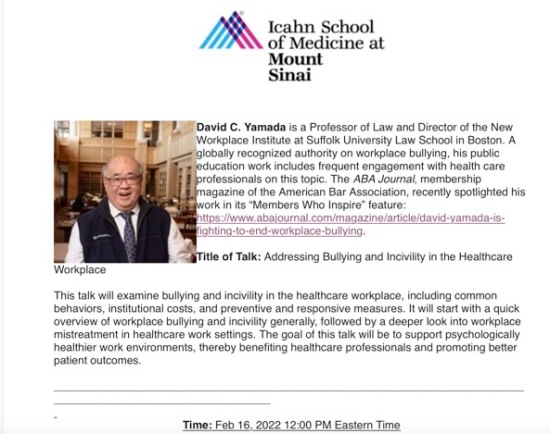
On Wednesday, I discussed bullying, mobbing, and incivility in healthcare workplaces at a Grand Rounds session hosted by the Icahn School of Medicine at Mount Sinai, Department of Environmental Medicine and Public Health, in New York City. It was a welcomed opportunity to discuss the challenges of the current healthcare work environment with physicians and other professionals.
Grand Rounds are a form of continuing professional education for those who work in healthcare settings. Sessions typically feature a presentation plus Q&A. Although many Grand Rounds presenters are experts in specific areas of healthcare practice and delivery, at times folks from related fields are invited to present.
When I first became involved with anti-bullying work in the late 1990s, it soon became evident that many healthcare workplaces were sites of significant bullying and related behaviors. I first started hearing accounts of bullying from nurses. Then came the stories from physicians, residents, and medical students. These streams of reports have remained consistent over the years.
Fortunately, some positive signs have appeared as well, at least at the bird’s eye level. Here in the U.S., two significant professional bodies — the Joint Commission and the American Medical Association — have now weighed in strongly against bullying-type behaviors.
The Joint Commission
In 2008 (modified and reaffirmed in 2021), the Joint Commission — an independent, non-profit organization that accredits health care organizations and programs — issued a standard on intimidating and disruptive behaviors at work, citing concerns about patient care (link here):
Intimidating and disruptive behaviors can foster medical errors, contribute to poor patient satisfaction and to preventable adverse outcomes, increase the cost of care, and cause qualified clinicians, administrators and managers to seek new positions in more professional environments. Safety and quality of patient care is dependent on teamwork, communication, and a collaborative work environment. To assure quality and to promote a culture of safety, health care organizations must address the problem of behaviors that threaten the performance of the health care team.
As you can see, the Joint Commission’s primary focus was on how bullying-type behaviors can have a negative impact on patient care.
American Medical Association
More recently, the American Medical Association — the largest national association representing the interests of doctors and other healthcare stakeholders — has issued statements, reports, and training materials covering bullying and related behaviors. The AMA defines workplace bullying as (link here):
…repeated, emotionally or physically abusive, disrespectful, disruptive, inappropriate, insulting, intimidating, and/or threatening behavior targeted at a specific individual or a group of individuals that manifests from a real or perceived power imbalance and is often, but not always, intended to control, embarrass, undermine, threaten, or otherwise harm the target.
These 2020 developments are shared on the AMA website (link here):
- “‘Bullying in the workplace is a complex type of unprofessional conduct. Bullying in medicine happens as a result of a combination of individual, organizational and systemic issues,’ says an AMA Board of Trustees Report on the topic. ‘The first line of defense against this destructive behavior are physicians, residents and medical students. There is no justification for bullying, disrespect, harassment, intimidation, threats or violence of any kind to occur among professionals whose primary purpose is to heal. Physicians choose medicine as their life’s work for many reasons, one of the most important being their desire to help and care for people.'”
- The AMA House of Delegates “adopted guidelines for the establishment of workplace policies to prevent and address bullying in the practice of medicine, saying that ‘health care organizations, including academic medical centers, should establish policies to prevent and address bullying in their workplaces.'”
In 2021, the AMA published a short training guide, Bullying in the Health Care Workplace: A Guide to Prevention and Mitigation, which can be accessed here.
My Advice
I closed my prepared remarks with recommendations on how healthcare institutions can address bullying behaviors, adapting them from a recently published piece on bullying in the legal profession, written for the American Bar Association:
- “Understand that health care professionals have not necessarily been trained to work well with others. Some may not grasp the distinctions between assertive, aggressive, and abusive behaviors.”
- “Include all stakeholders, recognizing that bullying can be vertical (typically top-down) and horizontal/lateral (peer(s) to peer(s)).”
- “For healthcare employers, start at onboarding and orientation, messaging to new hires that everyone should be treated with dignity and respect.”
- “Include bullying in employee handbooks and employee training programs, per AMA recommendations.”
- “Use climate surveys and 360 feedback mechanisms to help identify problems concerning bullying and related behaviors. Don’t sweep bad reports under the rug.”
- “Consider coaching, counseling, and – if necessary – termination for abusive individuals, even if they are proficient in other areas of their performance.”
- “Medical and nursing schools should include bullying and incivility in their curricula.”
- “Especially during the pandemic, incivility and bullying behaviors from patients and their families should be part of education, training, and institutional responses.”
***
As I noted during my presentation, all the best practices and policies aren’t worth a thing if they are not implemented and followed with good intentions. But the fact that national healthcare associations are recognizing the harms caused by bullying behaviors to workers and patients alike is encouraging.
The Mount Sinai event attracted a strong turnout, and I received very positive feedback on the session from the program organizers. As I said to those who attended, I am especially grateful to all healthcare providers during this pandemic. I hope that they found the hour we spent together useful and interesting.


